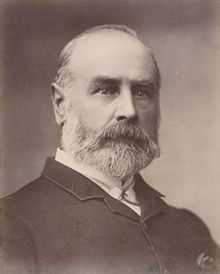Thomas Rowe
| Thomas Rowe - Architect | |
|---|---|
 | |
| Born |
20 July 1829 Penzance, Cornwall, England |
| Died |
14 July 1899 (aged 69) Darling Point, New South Wales, Australia |
| Nationality | British |
| Occupation | Architect |
| Buildings |
Great Synagogue, Elizabeth Street, Sydney Newington College, Stanmore Sydney Hospital, Macquarie Street, Sydney |
| Projects | Numerous Methodist churches |
Thomas Rowe (20 July 1829 – 14 January 1899) was one of Australia's leading architects of the Victorian era.[1]
Biography
Thomas Rowe was born in Penzance, Cornwall, United Kingdom, the eldest son of Richard Rowe and Ursula Mumford, and attended Barnes Academy. At 15 he became a draftsman in his father's building business before the family emigrated to Australia in 1848. From 1857 he practised as an architect in Sydney, Bathurst, Orange, Newcastle and Goulburn. He was often successful in competitions and his firms built commercial premises, large houses and many Methodist churches. Rowe Street in Sydney is named after him. He died in 1899 in Mona, a heritage-listed[2] house in Darling Point, New South Wales. Rowe's son Harry Ruskin Rowe was also successful as an architect. One of his most significant achievements was the creaton in 1950 of Ruskin Rowe, an estate in Avalon, New South Wales. The estate still exists and is heritage-listed.[3]
Key works
(Many of the following buildings are heritage-listed):[4]
- Chatswood South Uniting Church, Artarmon, New South Wales (1871)
- Presbyterian Church, Bridge Road, Glebe, New South Wales (1881)
- Original Randwick Borough Chambers (later Parish Centre of St Jude's Church, Randwick) (1862)
- Catherine Hayes Building (based on design by John Horbury Hunt), Prince of Wales Hospital, Randwick, New South Wales (1870)
- Tresco, Elizabeth Bay, New South Wales (1868)
- F.L. Kelly and Company Building, Yass, New South Wales (1869)
- St Paul's Presbyterian Church, Hill End, New South Wales (1872)
- Presbyterian Church, Bathurst (1871)
- Aliiolani Hale, Honolulu, Hawaii (1872)[5]
- Great Synagogue, Elizabeth Street, Sydney (1874)
- Sydney Hospital, including Nightingale Wing, Macquarie Street, Sydney (1879)
- Newington College, Stanmore (1878)
- Sydney Arcade, Pitt Street, Sydney (1874)
- Vickery's Building, Pitt Street, Sydney (1874)
- Ashton, Elizabeth Bay Road, Elizabeth Bay[6]
-
Founders' Wing, Newington College
-
Sydney Hospital, Macquarie Street
-

Great Synagogue, Elizabeth Street
-
Ashton, Elizabeth Bay
Architectural Partners
- W.B.Field
- Sydney Green
- Alfred Spain[7]
References
- ↑ M Freeland, Thomas Rowe, pp 68–69, Volume 6, Australian Dictionary of Biography (MUP, 1976)
- ↑ State Heritage Website
- ↑ State Heritage Website
- ↑ The Heritage of Australia, Macmillan Company, 1981, pp. 2/34,38,60,61,81,95,99,174,252,260
- ↑ Hawaii for visitors
- ↑ M Berry, A History of Colonel Thomas Rowe (B Arch thesis, UNSW, 1969)
- ↑ J M Freeland, The Making of a Profession (Syd, 1971)
| Wikimedia Commons has media related to Thomas Rowe. |
|


